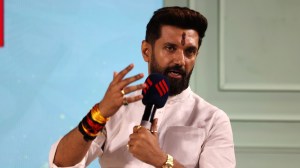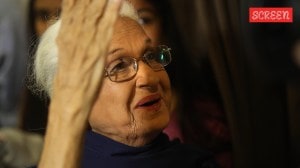Raja Babu (3), lost his life to acute encephalitis syndrome (AES) a fortnight ago. His father, Birendra Sahni from Sivuri Bihalbara village in Bihar’s Muzaffarpur district, said he could barely afford to provide his four children with milk on the Rs 300 he earned per day, and said that rice, lentil pulse and potato were all he could provide to his family.
Sahni said he had not heard of the nutrition rehabilitation centre at Muzaffarpur town for severally malnourished children below five years.

Prime Minister Narendra Modi on Wednesday expressed dismay and sorrow over the deaths of children due to AES — including around 150 children in Bihar alone — calling it a “matter for shame” for governments and society.
Story continues below this ad
READ | At Ground Zero of AES, govt schemes have little impact
Experts have blamed heat, humidity and malnutrition for AES. The fourth National Family Health Survey (NFHS-4), released in 2015-16 — the latest credible findings of health indices — had pointed to the malnutrition factors being prevalent in the country.
Some of the key findings of the NFHS-4 were:
> Nutritional status of children (percentage below three standard deviations of weight for age, weight for height and weight for age): The survey showed instances of stunting – the main fallout of malnutrition — in 8.2 per cent children below six months, 9.9 per cent children between six and eight months, 14.9 per cent children between nine and 11 months, 21.1 per cent children between 12 and 17 months, 29 per cent children between 18 and 23 months, 28.2 per cent children between 24 and 35 months, 25.9 per cent children between 36 and 47 months and 24.7 per cent children between 48 and 59 months.
> Children between 0-71 months who received any benefit under (ICDS): The survey, done once every 10 years, showed that aanganwadi workers were able to provide the scheme benefits (distribution of three and half kg rice, 1.5 kg pulse and 500 gm soybean to parents of children below three years and providing meals at aaganwadi centres to children between three and six years, immunisation) to 53.2 per cent children below 12 months, 57.8 per cent children between 12 and 23 months, 51 per cent children between 24 and 35 months, 47 per cent children between 36 and 47 months and 43.4 per cent children between 48 and 59 months and 39.6 per cent children between 60 and 71 months.
Story continues below this ad
 According to the state Health department, more than 700 children have been afflicted by AES in 20 districts since June 1 out of whom more than 150 have died.
According to the state Health department, more than 700 children have been afflicted by AES in 20 districts since June 1 out of whom more than 150 have died.
> Prevalence of anaemia in children below five years: The NFHS-4 survey showed high prevalence of moderate anaemia (7-9.9 gm/dl) among children. While children between six and 11 months reported 38.9 per cent moderate cases of anaemia in children between six and 11 months, 43.7 per cent in children between 12 and 23 months, 33.5 per cent between 24 and 35 months, 26.5 per cent between 36 and 47 months and 20.3 per cent between 48 and 59 months.
> Vaccination: The survey showed that 61.7 per cent children between 12 and 23 months were vaccinated. Muzaffarpur district registered 55 per cent vaccination in this age group.
> Poor diarrhoea management: The survey showed a high percentage of children not receiving any treatment for diarrhoea. The survey showed 42.2 per cent children below six months had not received any treatment for diarrhoea. The survey, however, showed that 70.7 per cent people between 15-19 years age group had knowledge of ORS. About 70 per cent people of 20 and 49 years also had knowledge of ORS packets.
OPINION | Let’s politicise health
An interaction with the families of some AES-affected children in Bihar reveals that many were not receiving a supplementary diet (such as milk) from aaganwadi centres under the ICDS, and none of the families confirmed having sent their children to a nutrition rehabilitation centre.
Story continues below this ad
Raj Kishor Ram, a resident of Jagarnathpur Dok village in Bihar’s Saraiya, lost his four-year-old son Subodh a fortnight ago. “Khichri is all that my child got at the aanganwadi centre. We were not told about any nutrition centre,” said Ram.
It is job of aanganwadi sevikas and ASHA workers to recommend severely malnourished children to a nutrition rehabilitation centre, where a child below is kept for a month.
A visit to the Muzaffarpur nutrition rehabilitation centre revealed a 20-bed centre in a two-storey building. The centre has 20 beds, of which only seven were occupied at the time of the visit. Since June 1, 40 children have been admitted to the centre, but though a child has to kept there for a month, most children were discharged within 15 days.
 As per norms, a nutrition rehabilitation centre has to provide treatment and management of patients besides “nutritious food”.
As per norms, a nutrition rehabilitation centre has to provide treatment and management of patients besides “nutritious food”.
At the centre, two auxiliary nurse midwifes (ANMS) work in two shifts. Since a dietician left the centre this January, no dietician has been posted. Rice, lentil pulse and potato vegetables (dry and with gravy) are served during the day.
Story continues below this ad
Sujata Devi brought her six-month-old son to the centre a few days ago. “Every child gets 75 ml milk in the morning. Parents get two meals for free. It is surely better than what we eat, but a child should be given more milk,” she said.
As per norms, a nutrition rehabilitation centre has to provide treatment and management of patients besides “nutritious food”. ANM Vimla Kumari said: “Our job is also to create nutrition awareness and tell parents how to prepare nutritious diet from available food and vegetables.”
Meanwhile, Muzaffarpur civil surgeon S P Singh said: “We are too busy with AES awareness campaign to talk about other things.”

 AES patients at Sri Krishna Medical College and Hospital, Muzaffarpur on June 23. (Express photo by Ritesh Shukla)
AES patients at Sri Krishna Medical College and Hospital, Muzaffarpur on June 23. (Express photo by Ritesh Shukla)
 According to the state Health department, more than 700 children have been afflicted by AES in 20 districts since June 1 out of whom more than 150 have died.
According to the state Health department, more than 700 children have been afflicted by AES in 20 districts since June 1 out of whom more than 150 have died. As per norms, a nutrition rehabilitation centre has to provide treatment and management of patients besides “nutritious food”.
As per norms, a nutrition rehabilitation centre has to provide treatment and management of patients besides “nutritious food”.





